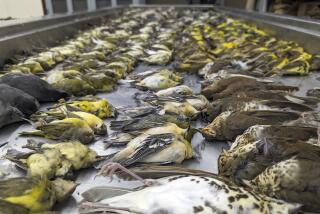Murder and maggots: It’s a bug’s-life ‘CSI’
- Share via
CHICAGO — In a famous poem, Emily Dickinson wrote, “I heard a fly buzz when I died.”
And according to the forensic entomologists who examine murder scenes for insect evidence, there’s a good chance Dickinson eventually did.
“The first witness to a death is usually a fly,” says Mike Sarna, director of exhibitions at the Peggy Notebaert Nature Museum. “Their sense of smell is so acute that they’ve been known to fly two miles to get to a fresh corpse.”
The Chicago museum has turned a focus on flies, maggots, carrion beetles and other corpse eaters for its new exhibition, “CSI: Crime Scene Insects,” which runs through Sept. 12.
It is not for the youngest or most fastidious museumgoers.
The show is curated by Lee Goff, an entomological consultant for the FBI and other law enforcement agencies worldwide as well as for the hit “CSI” television shows. He said several plot lines for the series have come from his book “The Fly for the Prosecution.”
Goff credits the TV shows’ popularity for the interest in the exhibition, which has already been in St. Paul, Minn., and Roanoke, Va., and is booked solid through 2007.
The exhibition setup requires a bit more than tweaking light levels. It needs plenty of fresh fly eggs, live beetles and termites. And the freezer has to be stocked with dead pigs.
Two of the pigs were lying in wire cages on a strip of lawn in back of the museum the other day. “When the exhibition opens, we’ll have five of them here, in successive stages of decomposition,” Sarna explained. “We’re just getting started with these two.”
The more pungent pig was nothing more than a pile of hide, bones and teeth.
“The maggots and carrion beetles are finished with this one. The soft tissue is gone,” Sarna said. “Now it’s the turn of the dermestid [skin and tendon-eating] beetles. Eventually, other beetles and termites will eat the bones.”
Inside, the exhibit includes morgue drawers containing two simulated cadavers showing the early and later stages of insect infestation.
“Once we know the species of the fly and the temperature, we can be very precise in finding the time of death,” said Goff, who is also chairman of the forensic sciences program at Chaminade University of Honolulu.
The exhibition includes two mock-ups of real cases, where visitors can use what they have learned about insects and decomposition.
More to Read
The biggest entertainment stories
Get our big stories about Hollywood, film, television, music, arts, culture and more right in your inbox as soon as they publish.
You may occasionally receive promotional content from the Los Angeles Times.










